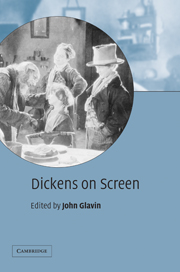Book contents
- Frontmatter
- Contents
- List of illustrations
- Notes on the contributors
- Acknowledgments
- Introduction
- Part I
- Part II
- Part III
- Part IV
- 11 Cinematic Dickens and uncinematic words
- 12 Dickens, Eisenstein, film
- 13 Orson Welles and Charles Dickens 1938–1941
- 14 David Copperfield (1935) and the US curriculum
- 15 Dickens, Selznick, and Southpark
- 16 Tiny Tim on screen: a disability studies perspective
- Part V
- Index
- References
16 - Tiny Tim on screen: a disability studies perspective
Published online by Cambridge University Press: 22 September 2009
- Frontmatter
- Contents
- List of illustrations
- Notes on the contributors
- Acknowledgments
- Introduction
- Part I
- Part II
- Part III
- Part IV
- 11 Cinematic Dickens and uncinematic words
- 12 Dickens, Eisenstein, film
- 13 Orson Welles and Charles Dickens 1938–1941
- 14 David Copperfield (1935) and the US curriculum
- 15 Dickens, Selznick, and Southpark
- 16 Tiny Tim on screen: a disability studies perspective
- Part V
- Index
- References
Summary
A rail-thin boy with a sugarbowl haircut sweetly sings “Hark ! The Herald Angels Sing” as his adoring family listens. Another lad declines an impromptu sliding contest on an icy London street, cheerfully noting that “I'm not very good at running.” A boy suffering from a generic malady assures his father during a transatlantic telephone call that “I'll be okay; I'm just tired.” Another father asks his son to name his favorite toy in a storefront window display, and the boy good-naturedly responds, “You said I can't have none of 'em, so I might as well like 'em all.” A mute boy, the only African-American in the group, allows his siblings to decorate him as a Christmas tree. A cartoon mouse and a puppet frog hobble about on crutches.
As the astute reader has already discerned, I have based the above pastiche of word-images on moments from several screen adaptations of Charles Dickens's A Christmas Carol: in order, Scrooge (1935), A Christmas Carol (1938), A Diva's Christmas Carol (2000), Scrooge (1970), Scrooged (1988), Mickey's Christmas Carol (1983), and The Muppet Christmas Carol (1992). It centers, furthermore, on one of the most famous disabled fictional characters of all time: that crutch-bearing Cratchit urchin, Tiny Tim.
- Type
- Chapter
- Information
- Dickens on Screen , pp. 188 - 198Publisher: Cambridge University PressPrint publication year: 2003
References
- 1
- Cited by



